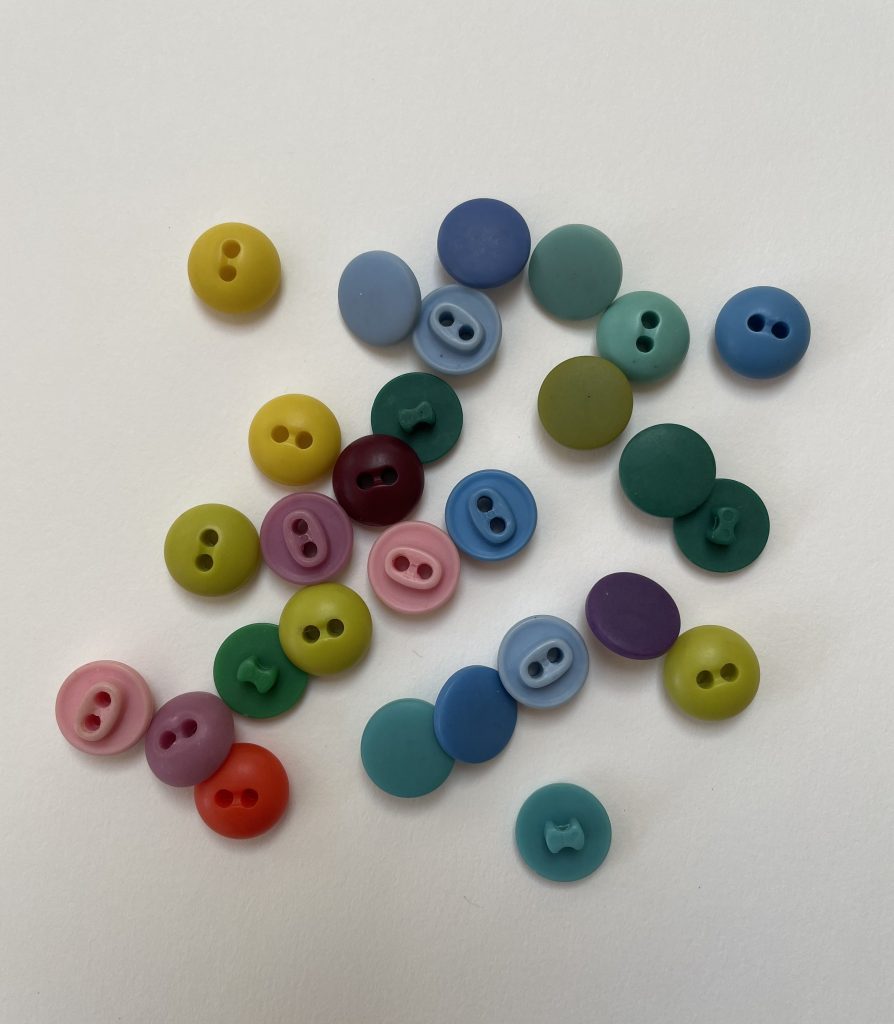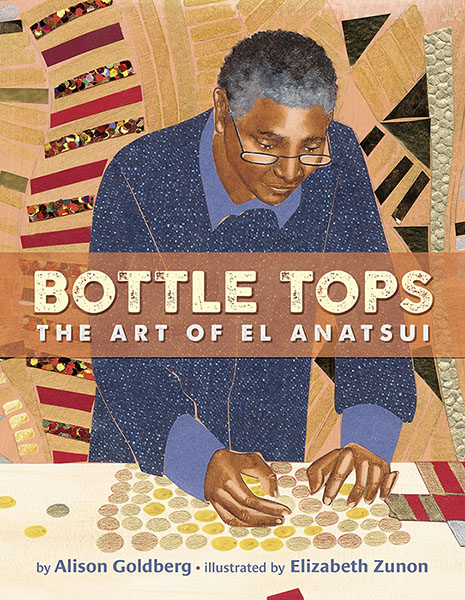In this guest post, author Alison Goldberg explores how found objects can reveal their stories when turned into art, just as El Anatsui’s sculptures reveal the stories of the objects that they are made from. Bottle Tops: The Art of El Anatsui will be published on June 14, 2022 and is available for preorder.
When I was a child, I loved to play with a tray of buttons. A rainbow of tiny plastic domes, these buttons reminded me of those candies that come on strips of paper. I strung them into necklaces and glued them into collages. They were given to me by my grandmother. They had been discarded from the garment factory where she worked in New York City, and she brought them home for me.
Buttons are ordinary, everyday objects, and these buttons had been thrown away. As a child, they caught my attention but I didn’t consider their significance. I still have a few—bright blue, green, and yellow—and when I reflect on them now, I see them in a different light. I wonder about their stories.
My new picture book, Bottle Tops: The Art of El Anatsui, illustrated by Elizabeth Zunon, is a biography of the acclaimed artist, El Anatsui. He was born in Ghana and now lives in Nigeria. He makes sculptures with materials from his environment, including broken cooking utensils, old printer plates, bottle tops, and other objects that have passed through human hands. El Anatsui encourages artists to work with “whatever their environment throws up.” He considers the stories that objects hold, and in bottle tops, he sees a strong reference to the history of Africa. Bottles like the ones these tops sealed were first introduced to Africa by Europeans. Through his art, El Anatsui transforms this material to tell stories about history and culture and the environment. He says the material itself carries a charge: “If you touch something, you leave a charge on it and anybody else touching it connects with you, in a way.”
El Anatsui’s innovative sculptures challenge viewers to consider layers of meaning, including the stories of the media itself. His work demonstrates how powerful it can be when artists use the ordinary things around them to make art.

Now when I look at the buttons from my grandmother, I’m inspired to dig deeper. I wonder if I could construct something from them that reveals their stories. Stories about women like my grandmother who worked in the garment industry in New York City, whose hands these buttons passed through. About how clothing was made during the last century and how that changed. About plastic and waste. I wonder if these buttons could share a story about my grandmother, who worked in a garment factory for decades but knitted her own dresses by hand.
Whether we look to buttons or food wrappers or shoelaces or magazine pages or fabric scraps or packaging material or old crayons or aluminum cans, discarded objects can evoke stories, and those stories can be worthwhile to explore in art-making. In the back of Bottle Tops is a sculpture activity using the foil tops from fruit and yogurt cups and other food containers. This activity can be done by a family or classroom and with a small or large group. It is intended as a warm-up, to prompt questions about which objects hold meaning for each to us, and how we can transform those objects into art that carries and shares our stories. I hope it is a jumping-off point for making art from the everyday.
Pre-order your copy of Bottle Tops:
IndieBound
Bookshop
Barnes & Noble
Amazon
. . . or wherever you order your favorite books!

Alison Goldberg is a writer based in Cambridge, Massachusetts, and the author of I Love You for Miles and Miles. She blogs about activism in children’s literature and loves researching everything from marine life to contemporary art for her books. Alison first learned about El Anatsui’s work while studying art in Ghana in 1995 and has sought opportunities to see his sculptures ever since. You can visit her online at alisongoldberg.com.


